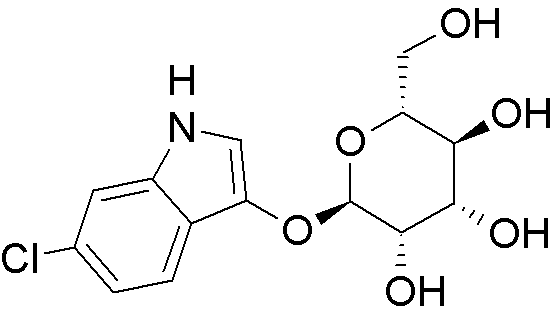6-Chloro-3-indoxyl-a-D-mannopyranoside is widely utilized in research focused on:
- Enzyme Substrates: This compound serves as a substrate for various enzymes, particularly in glycosylation studies, allowing researchers to investigate enzyme activity and specificity.
- Biochemical Assays: It is commonly employed in biochemical assays to detect and quantify specific enzymes, providing a reliable method for monitoring biological processes in laboratories.
- Plant Research: In plant biology, it is used to study gene expression and metabolic pathways, helping scientists understand plant responses to environmental changes.
- Diagnostic Applications: The compound can be utilized in diagnostic kits for detecting certain diseases, offering a practical tool for medical professionals in clinical settings.
- Pharmaceutical Development: It plays a role in the development of new drugs, particularly those targeting glycosylation processes, which can enhance the efficacy and specificity of therapeutic agents.
General Information
Properties
Safety and Regulations
Applications
6-Chloro-3-indoxyl-a-D-mannopyranoside is widely utilized in research focused on:
- Enzyme Substrates: This compound serves as a substrate for various enzymes, particularly in glycosylation studies, allowing researchers to investigate enzyme activity and specificity.
- Biochemical Assays: It is commonly employed in biochemical assays to detect and quantify specific enzymes, providing a reliable method for monitoring biological processes in laboratories.
- Plant Research: In plant biology, it is used to study gene expression and metabolic pathways, helping scientists understand plant responses to environmental changes.
- Diagnostic Applications: The compound can be utilized in diagnostic kits for detecting certain diseases, offering a practical tool for medical professionals in clinical settings.
- Pharmaceutical Development: It plays a role in the development of new drugs, particularly those targeting glycosylation processes, which can enhance the efficacy and specificity of therapeutic agents.
Documents
Safety Data Sheets (SDS)
The SDS provides comprehensive safety information on handling, storage, and disposal of the product.
Product Specification (PS)
The PS provides a comprehensive breakdown of the product’s properties, including chemical composition, physical state, purity, and storage requirements. It also details acceptable quality ranges and the product's intended applications.
Certificates of Analysis (COA)
Search for Certificates of Analysis (COA) by entering the products Lot Number. Lot and Batch Numbers can be found on a product’s label following the words ‘Lot’ or ‘Batch’.
*Catalog Number
*Lot Number
Certificates Of Origin (COO)
This COO confirms the country where the product was manufactured, and also details the materials and components used in it and whether it is derived from natural, synthetic, or other specific sources. This certificate may be required for customs, trade, and regulatory compliance.
*Catalog Number
*Lot Number
Safety Data Sheets (SDS)
The SDS provides comprehensive safety information on handling, storage, and disposal of the product.
DownloadProduct Specification (PS)
The PS provides a comprehensive breakdown of the product’s properties, including chemical composition, physical state, purity, and storage requirements. It also details acceptable quality ranges and the product's intended applications.
DownloadCertificates of Analysis (COA)
Search for Certificates of Analysis (COA) by entering the products Lot Number. Lot and Batch Numbers can be found on a product’s label following the words ‘Lot’ or ‘Batch’.
*Catalog Number
*Lot Number
Certificates Of Origin (COO)
This COO confirms the country where the product was manufactured, and also details the materials and components used in it and whether it is derived from natural, synthetic, or other specific sources. This certificate may be required for customs, trade, and regulatory compliance.


